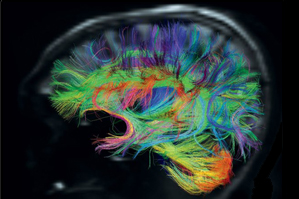Guest Post: The one billion map

Earlier this month, the Obama administration announced its plan to put $100 million toward building a network map of the human brain. World leading network scientist and Northeastern Distinguished Professor Albert-László Barabási is excited about the new project, but says the so-called “connectome” of neural interactions in the brain is but one network of many deserving more attention and funding. Here he discusses the network of molecular interactions in the body that define and determine disease. This post was originally published on the Facebook page for Network Science: Interactive Textbook, a project of Barabási and his colleagues at the Center for Complex Network Research.
For a network scientist few things can be more exciting that when the US government commits $100 million a year for its most massive network mapping initiative ever: obtain a map of the connectome, a complete circuitry of the brain. The effort’s scale and complexity only compares to Google’s mighty operation to map out the WWW and Facebook’s ambition to map out the world’s social circuitry. Yet, it also reminds us of our biggest map-making challenge to date: the lack of a map of the interactome, representing the full list of molecular interactions between the genes in a human cell. The absence of this map remains the major barrier between the $3 billion investment into genomics and our ability to cure human disease.
A car with dysfunctional lights has many similarities to a human with a disease. There is one difference, however: if we get the car to a mechanic, we are certain that he will be able to fix it. Why can the mechanic, with far less education than a doctor, guarantee to fix our car, while many human diseases remain untreated? To begin with, the mechanic has the complete parts list. Well, so does the doctor: the Human Genome Project offered for the first time the full inventory of the cell’s components, a comprehensive list of genes, proteins and RNAs. We fully expected that this parts list would result in a bonanza of new drugs and treatments. It did not. In 2000, the year before the human genome was unveiled, the FDA approved over a hundred drugs. This number fell to about twenty a year a decade later.
In hindsight, your car’s parts list is not sufficient to fix your lights either. The mechanic also needs the car’s wiring diagram, telling him to check the battery, the fuses, and the switches, to look for loose cables instead of checking the tire pressure. Similarly, if we ever want to develop new drugs and cure disease, we need a detailed map, telling us how our genes and proteins work together. Indeed, countless studies have shown that knowing the genes mutated in cancer, asthma, or schizophrenia is insufficient to understand and cure the disease. These are true networks diseases: the failures of the components make sense only in the context of the networks in which they participate.
The challenge of the connectome and the interactome cannot be more different. The goal of the unveiled connectome initiative is to develop the technologies that one day will help us map the brain. In contrast, the tools to map the interactome are largely available. For example, during the last decade Marc Vidal, a geneticist from the Dana Farber Cancer Institute and many others have tirelessly improved the tools to map all binding interactions between the proteins of a human cell. Collaborating with Vidal, in 2007 we estimated that the maps available back then were about 5% complete. This year they are about to reach a landmark: a map that contains 20% of the links. However, that also means that we are still missing 80% of the interactions. Imagine that your mechanic’s blueprint would lack 80% of the car’s internal circuitry—would you ever dare to take your car to him?
Perhaps the most profound discovery of network science is that fundamentally different networks, such as the WWW, the cell, or the social network, are governed by similar laws and have a common blueprint. How about the brain? Do hubs, like Google is on the WWW or the P53 protein is in the human cell, dominate its architecture? Do nodes form tightly linked communities, as humans do in the social network? Is our brain a small world? Lacking brain maps, we have no idea. The human brain is truly terra incognita from the network perspective. The connectome aims to change that, offering hope that one day we will have the tools to uncover the brain’s fundamental patterns of connectivity. In the case of the interactome we have the tools to map it out. What the research community lacks is the will and the resources to see it to the end. And while we can only imagine the benefits of the connectome, we know exactly what we loose by not pursuing the interactome: we are letting a $3 billion investment into genomics unexploited. And with that, countless diseases remain untreated.





